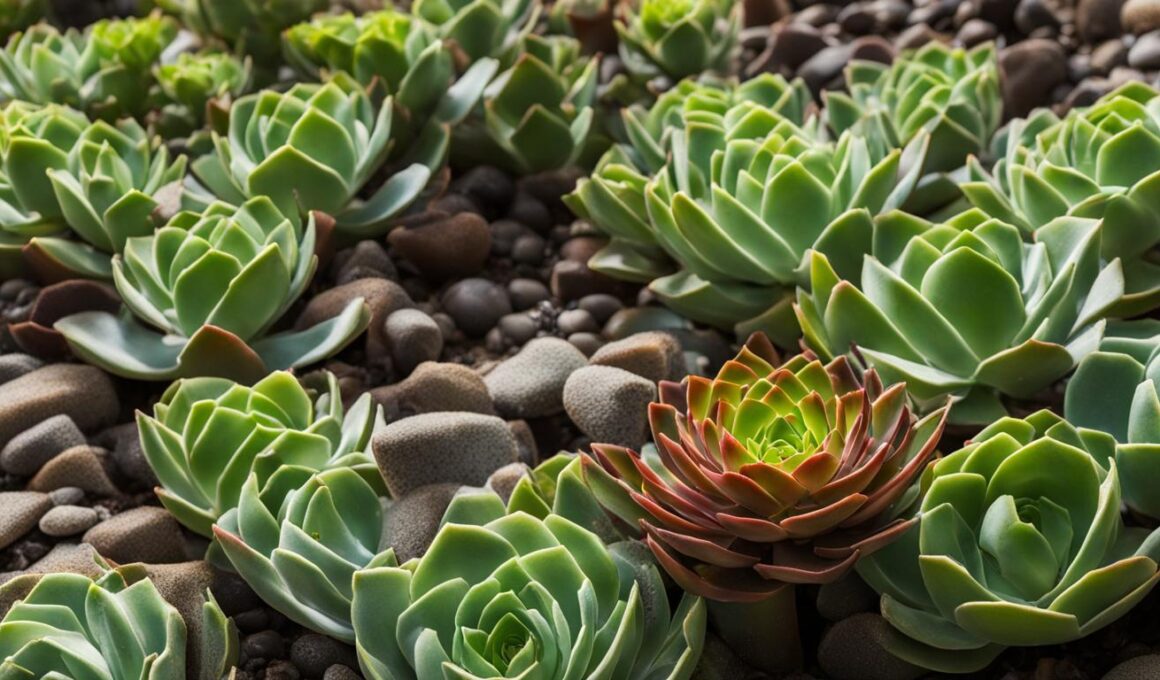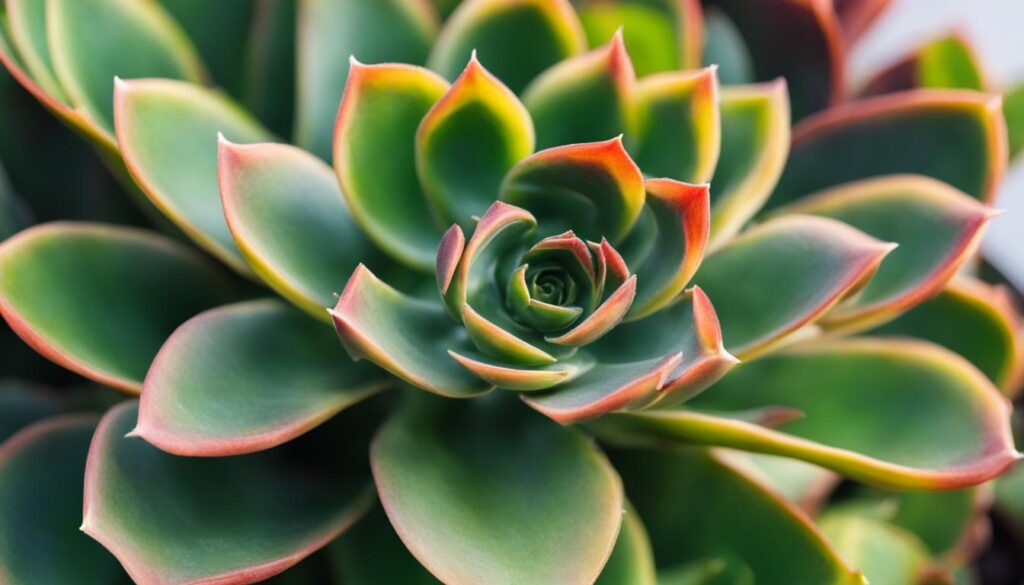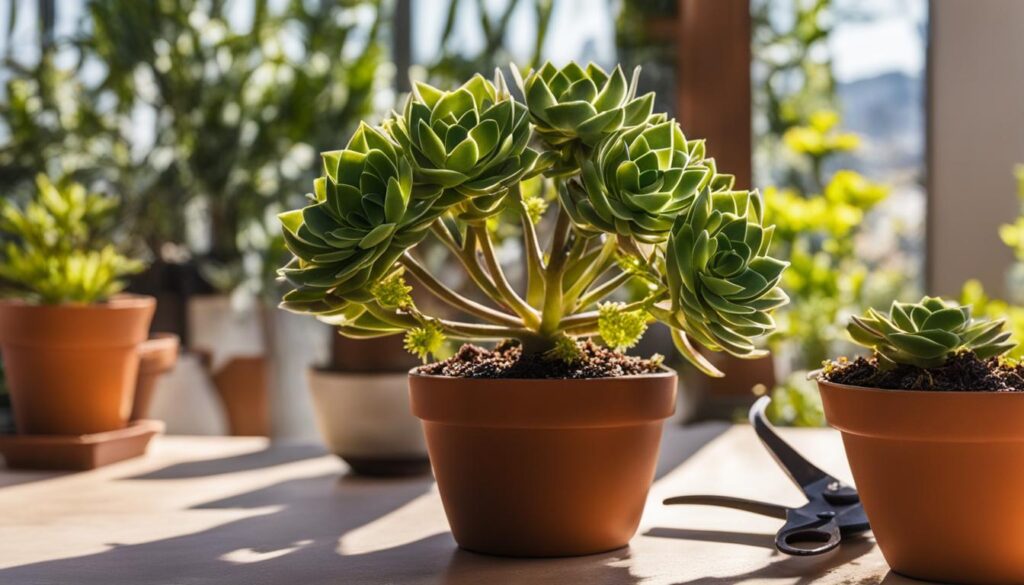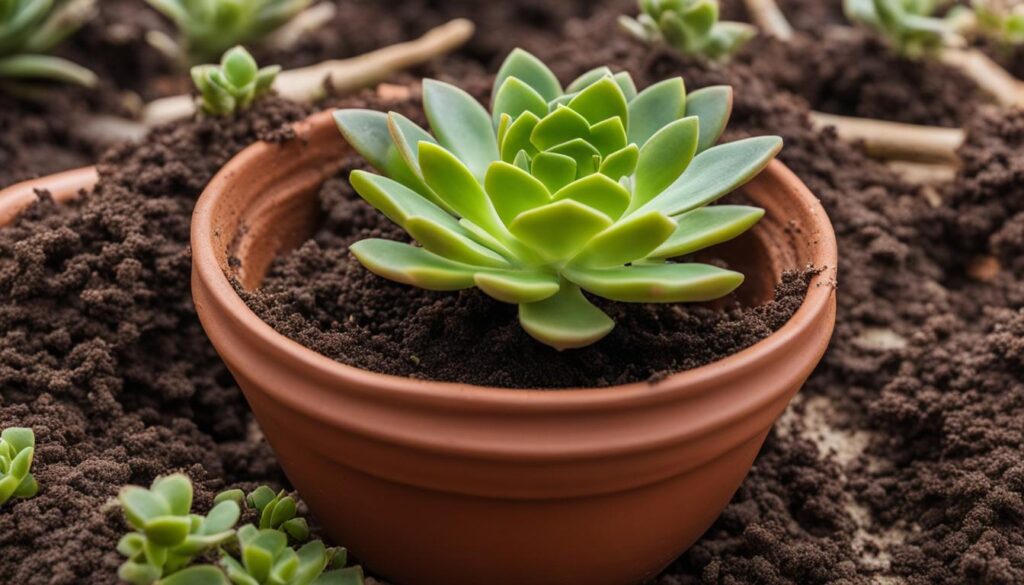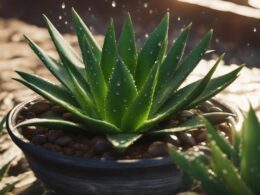If you’re a gardening enthusiast looking to make your Aeonium plant branch out, you’ve come to the right place. Branching out not only enhances the aesthetic appeal of your plant but also promotes healthier growth. In this article, we’ll explore simple gardening tips to help your Aeonium thrive and achieve a beautifully branching structure.
Post Summary
- Experiment with cutting off the top or carving out the growing point to encourage branching in your Aeonium plant.
- Aeonium plants are evergreen succulents that come in various species and varieties, such as Aeonium arboreum ‘Zwartkop’ and Aeonium decorum ‘Sunburst’.
- Provide your Aeonium with full sun, well-draining soil, and minimal water to create ideal growing conditions.
- Water your Aeonium plant sparingly and use a well-draining soil mix to prevent overwatering and root rot.
- Prune your Aeonium plant to promote branching, maintain plant stability, and control its size.
Understanding Aeonium Plants
Aeonium plants are fascinating evergreen succulents that come in a wide variety of species and cultivars. These plants are known for their unique characteristics and visually striking appearance. With glossy, waxy leaves arranged in rosette shapes, Aeonium plants make stunning additions to any garden or indoor space.
Some popular varieties of Aeonium include Aeonium arboreum ‘Zwartkop’ and Aeonium decorum ‘Sunburst’. The ‘Zwartkop’ variety, also known as the Black Rose, features deep burgundy leaves that create a dramatic contrast with other plants. On the other hand, the ‘Sunburst’ variety showcases vibrant yellow and green variegated leaves, adding a pop of color to your garden.
Aeonium plants are relatively slow-growing and require specific growing conditions to thrive. They prefer full sun exposure, well-draining soil, and minimal water. These plants are native to the Canary Islands, so they are adapted to Mediterranean-like climates. It’s important to provide them with the right environment and care to ensure their health and longevity.
Aeonium Plant Varieties
| Variety | Characteristics |
|---|---|
| Aeonium arboreum ‘Zwartkop’ | Deep burgundy leaves, dramatic contrast |
| Aeonium decorum ‘Sunburst’ | Vibrant yellow and green variegated leaves, adds color |
| Aeonium haworthii ‘Kiwi’ | Tricolor leaves with pink, green, and white hues |
| Aeonium tabuliforme | Flat, disk-shaped leaves, also known as the Dinner Plate Aeonium |
Whether you’re a beginner gardener or an experienced plant enthusiast, Aeonium plants can be a rewarding addition to your collection. Their unique characteristics and stunning varieties make them stand out in any garden or indoor space. By understanding their specific needs and providing the right care, you can enjoy the beauty and resilience of Aeonium plants for years to come.
Growing Conditions for Aeonium Plants
If you want your Aeonium plants to thrive and branch out, it’s essential to provide them with the right growing conditions. These plants prefer full sun exposure, so make sure to place them in a location that receives at least 6-8 hours of direct sunlight each day. Aeoniums are not frost tolerant and require temperatures above 5°C, so it’s important to protect them during colder months.
In terms of watering, Aeoniums are succulents and do not require excessive moisture. They prefer well-draining soil, so make sure to plant them in a sandy or loamy soil mix that allows water to flow freely. Allow the soil to dry out between waterings and then water thoroughly, ensuring the water reaches the roots. Overwatering can lead to root rot, so it’s crucial to find the right balance.
If you choose to grow Aeonium plants in pots, this offers the advantage of easy movement and protection from frost. When growing in containers, make sure to use pots with drainage holes to prevent water from pooling at the bottom. You can also add a layer of gravel or small rocks at the bottom of the pot to further enhance drainage. Remember to keep an eye on the temperature and adjust accordingly to provide the best growing conditions for your Aeonium plants.
| Growing Conditions for Aeonium Plants | Requirements |
|---|---|
| Sunlight | Full sun exposure (6-8 hours daily) |
| Temperature | Above 5°C, not frost tolerant |
| Watering | Allow soil to dry between waterings, well-draining soil |
| Container Growing | Pots with drainage holes, gravel for enhanced drainage |
Growing Aeonium Plants: Tips and Tricks
- Choose a sunny spot for your Aeonium plants, ensuring they receive adequate sunlight.
- Protect your plants from frost by moving them indoors or providing cover during cold periods.
- Water sparingly and allow the soil to dry out between waterings to prevent root rot.
- If you prefer container gardening, use pots with drainage holes and add gravel for improved drainage.
By providing the right growing conditions and maintaining proper care, your Aeonium plants will thrive, branch out, and become a beautiful addition to your garden or indoor space.
Watering and Soil Needs for Aeonium Plants
Proper watering and soil conditions are essential for the health and vitality of Aeonium plants. These succulents have unique requirements that allow them to thrive in arid environments. Understanding the appropriate watering techniques and soil composition will help you maintain a successful Aeonium garden.
Watering Aeonium Plants
Aeonium plants are drought-tolerant and prefer to be kept on the drier side. Overwatering can lead to root rot and the decline of the plant. To ensure the right balance, allow the soil to completely dry out between waterings. Insert your finger into the soil up to the second knuckle; if it feels dry, it’s time to water. When watering, thoroughly soak the soil until water runs out of the drainage holes. Discard any excess water in the saucer to avoid waterlogged roots.
During the winter months, when Aeonium plants enter their dormancy period, reduce watering frequency even further. Aeoniums are more susceptible to root rot during this time, so it’s crucial to keep the soil dry. Monitor the moisture level closely and adjust watering accordingly.
Soil Needs for Aeonium Plants
The ideal soil mix for Aeonium plants should provide excellent drainage while retaining some moisture. A well-draining soil prevents waterlogging and allows the roots to breathe. To create the perfect soil mix, combine equal parts of sand, perlite, and multipurpose compost.
Avoid using heavy or clay-based soils as they tend to hold moisture, increasing the risk of root rot. Sandy or loamy soils are preferable as they provide better drainage. If planting Aeoniums in pots, ensure that the containers have drainage holes to prevent water from pooling at the bottom.
| Watering Tips for Aeonium Plants | Soil Composition for Aeonium Plants |
|---|---|
|
|
By following proper watering techniques and using a well-draining soil mix, you can provide the optimal conditions for your Aeonium plants. Remember, it’s better to underwater than overwater, as these plants are highly adapted to dry conditions. With time, patience, and the right care, you’ll see your Aeoniums thrive and flourish in their unique succulent beauty.
| Pruning Techniques for Aeonium Plants | Benefits |
|---|---|
| Removing leaves from the central rosette | Stimulates new branch growth |
| Creating a balanced shape through selective leaf removal | Enhances the plant’s visual appeal |
| Reducing weight from upper stem leaves | Improves plant stability |
| Controlling top-heavy growth | Maintains a compact and bushy appearance |
Propagation Methods for Aeonium Plants
Aeonium plants can be propagated through stem cuttings or by “beheading” the rosette. Stem cuttings should be taken during the active growth phase in the spring. Allow the cuttings to dry for a day or two before planting them in gritty compost. “Beheading” the rosette involves cutting off the top section and replanting it as a cutting. Both methods can be effective in propagating new Aeonium plants.
When propagating through stem cuttings, choose a healthy stem with several leaves. Use a clean, sharp knife or pruners to make a clean cut just below a leaf node. Remove the bottom leaves, leaving a few at the top. Let the cutting callus over for a day or two to prevent rotting, then plant it in a well-draining soil mix. Keep the soil slightly moist, but not overly wet, and place the cutting in a warm, bright location.
If you prefer to “behead” the rosette, make a clean cut just below the lowest leaves of the rosette. Allow the cut end to callus over for a day or two before planting it in a well-draining soil mix. Keep the soil slightly moist and place the cutting in a warm, bright location. New roots and shoots will develop from the cut end, eventually forming a new Aeonium plant.
| Propagation Method | Advantages | Disadvantages |
|---|---|---|
| Stem Cuttings | Relatively easy and reliable method Produces multiple new plants from a single cutting Allows for genetic replication of desired traits |
Requires waiting time for callus formation Not suitable for all Aeonium species |
| “Beheading” the Rosette | Quick and straightforward method Allows for immediate removal of overgrown or damaged rosettes Can result in a compact, bushy plant |
Requires sacrificing the original plant May take longer for new plants to establish roots |
Regardless of the propagation method you choose, it’s important to provide the right conditions for the new plants to thrive. Place them in a warm and bright location, but protect them from intense direct sunlight. Keep the soil slightly moist during the initial stages of growth, gradually reducing watering as the new plants establish roots. With proper care and attention, you can successfully propagate new Aeonium plants and expand your collection.
Aeonium Propagation Tips
- Choose healthy stems or rosettes for propagation.
- Use a clean, sharp knife or pruners to make clean cuts.
- Allow cuttings to callus over before planting.
- Provide a well-draining soil mix for optimal growth.
- Place cuttings or beheaded rosettes in a warm, bright location.
- Gradually reduce watering as new plants establish roots.
Creating an Environmentally-Friendly Garden to Combat Midges
Midges can be a nuisance in the garden, especially in areas with wet soils. However, there are environmentally-friendly ways to combat these pests and create a more harmonious garden habitat. By implementing certain strategies, you can reduce midge populations and promote a thriving ecosystem.
1. Planting Trees and Shrubs
One effective way to combat midges is by planting trees and shrubs in your garden. These plants can help absorb excess moisture in the soil, reducing the breeding grounds for midges. Choose varieties that thrive in your region and provide shade and shelter for beneficial insects and birds.
2. Attracting Predators
Attracting predators such as birds and bats can also help control midge populations. Birds like swallows and swifts feed on flying insects, including midges. Provide birdhouses and ensure a water source for them. Bats are natural predators of insects and can consume a large number of midges each night. Install bat boxes in your garden to provide roosting places for these beneficial creatures.
3. Planting Beneficial Flowers
Another way to combat midges is by planting a variety of flowers that attract beneficial insects. These insects, such as ladybugs and lacewings, prey on midges and help keep their populations in check. Choose flowering plants that provide nectar and pollen, such as marigolds, lavender, and daisies. These flowers will not only beautify your garden but also support a diverse ecosystem.
| Plant | Attract Beneficial Insects |
|---|---|
| Marigolds | Yes |
| Lavender | Yes |
| Daisies | Yes |
By creating an environment that is less favorable to midges and more attractive to their natural predators, you can significantly reduce their impact on your garden. Implement these strategies and enjoy a harmonious and pest-free outdoor space.
Saving Rainwater in Limited Space
If you have limited space for a traditional water butt, there are alternatives available that allow you to save rainwater efficiently. One such option is the Rainwater Hog, a compact and versatile solution. It can be placed horizontally or vertically, making it suitable for small spaces like balconies or courtyards. The Rainwater Hog has a capacity of up to 180 liters, providing ample storage for rainwater.
The Rainwater Hog is designed to be connected with multiple butts, enabling you to maximize your rainwater collection even with limited space. By interlinking multiple Hogs, you can double, triple, or even quadruple your rainwater storage capacity. This flexibility makes the Rainwater Hog an ideal choice for gardeners who want to make the most of their available space.
In addition to its practicality, the Rainwater Hog is also an aesthetically pleasing option. Its sleek design and range of color options allow it to blend seamlessly with any outdoor setting. Whether you have a modern or traditional garden, the Rainwater Hog can complement your space while serving as a sustainable water-saving solution.
By saving rainwater with the Rainwater Hog, you can reduce your reliance on mains water and contribute to a more sustainable future. It’s a simple yet effective way to conserve water and ensure you have a readily available supply for your Aeonium plants and other gardening needs.
“The Rainwater Hog is a compact and versatile option that can be placed horizontally or vertically. It can hold up to 180 liters of water and multiple butts can be connected.”
Conclusion
By implementing these gardening tips and proper plant care, you can successfully make your Aeonium plant branch out and thrive. Whether you choose to experiment with pruning techniques, propagate new plants, or create an environmentally-friendly garden, there are various methods to encourage branching and ensure the health of your Aeonium.
Remember to provide your Aeonium with the optimal growing conditions it needs, including ample sunlight, well-draining soil, and appropriate watering. These plants prefer a warm and sunny environment, so placing them in a south or west-facing aspect will ensure they receive enough sunlight to thrive.
In addition, creating an environmentally-friendly garden can help combat pests and promote a thriving ecosystem. Planting trees and shrubs, attracting beneficial insects, and providing a variety of flowering plants will contribute to a healthy garden habitat.
With these gardening tips and proper care, your Aeonium plant will transform into a lush and beautiful centerpiece for your garden. Enjoy the process of nurturing and watching your plant branch out, creating a stunning display of nature’s beauty.
Can the Method to Revive a Dogwood Tree be Applied to Aeonium to Make it Branch Out?
The method to revive a dogwood tree may not be directly applicable to helping an Aeonium branch out. Aeoniums have different growth patterns and requirements compared to dogwood trees. However, proper care, such as providing adequate sunlight, water, and nutrients, can promote healthy branching in Aeoniums.
FAQ
How can I encourage my Aeonium plant to branch out?
You can try cutting off the top or carving out the growing point to encourage new growing points to sprout from the nodes.
What are Aeonium plants?
Aeonium plants are evergreen succulents with glossy, waxy leaves arranged in a rosette shape. They come in various species and varieties, such as Aeonium arboreum ‘Zwartkop’ and Aeonium decorum ‘Sunburst’.
What are the growing conditions for Aeonium plants?
Aeonium plants thrive in full sun, well-draining soil, and require minimal water. They prefer temperatures above 5°C and are not frost tolerant.
How often should I water my Aeonium plant?
Allow the soil to dry out between waterings and then water the plant thoroughly. Aeonium plants do not require excessive watering.
How can I prune my Aeonium plant to encourage branching?
To promote branching, you can remove some leaves from the central rosette on the main stem or “leader.” Creating a bare patch in the middle of the rosette will stimulate the growth of new branches.
How can I propagate Aeonium plants?
Aeonium plants can be propagated through stem cuttings taken in the spring or by “beheading” the rosette and replanting the top section as a cutting.
How can I combat midges in my garden?
To combat midges in an environmentally-friendly way, create a diverse garden habitat by planting trees and shrubs, attracting predators such as birds and bats, and providing a variety of flowering plants to attract beneficial insects.
What are alternative options for saving rainwater in limited space?
If you have limited space for a traditional water butt, you can consider options like the Rainwater Hog, a compact and versatile option that can be placed horizontally or vertically and can hold up to 180 liters of water.
How can I make an Aeonium plant thrive?
By following the right techniques and care, including proper growing conditions, pruning, propagation, and creating an environmentally-friendly garden, you can make an Aeonium plant branch out and thrive.





